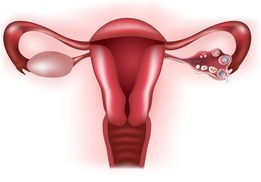Ovarian Cyst and Benign Tumors

Functional ovarian cysts may form when ovulation fails to occur (the egg is not released from the follicle), leaving the developing follicle to grow beyond its normal time (follicular cyst) and after ovulation if the corpus luteum persists (corpus luteum cyst). Ovarian cysts usually cause no symptoms, though you may experience a vague feeling of heaviness or pressure in the lower abdomen. Infrequently, they pose a problem when they rupture, bleed, or become twisted. Benign tumors are noncancerous ovarian tumors that usually grow slowly and rarely become cancerous.
Functional Cysts:
There are two types of functional cysts:
Benign tumors (noncancerous):
Benign ovarian tumors usually grow slowly and rarely become cancerous. The most common include the following:
Most functional cysts and noncancerous tumors do not cause any symptoms. Sometimes women have irregular periods and spotting. If corpus luteum cysts bleed, they may cause pain or tenderness in the pelvic area. Occasionally, sudden, severe abdominal pain occurs because a large cyst or mass causes the ovary to twist (a disorder called adnexal torsion) which is a medical emergency. Accumulation of fluid in the abdomen (ascites) can occur with fibromas and ovarian cancer. Ascites may cause a feeling of pressure or heaviness in the abdomen.
If you have any of the symptoms above please contact Dr. Linda Gedeon to discuss the best treatment options for you.
Functional Cysts:
There are two types of functional cysts:
- Follicular cysts: These cysts form as the egg is developing in the follicle.
- Corpus luteum cysts: These cysts develop from the structure that forms after the follicle ruptures and releases its egg. This structure is called the corpus luteum. Corpus luteum cysts may bleed, causing the ovary to bulge or to rupture. If the cyst ruptures, fluids escape into spaces in the abdomen (the abdominal cavity) and may cause severe pain.
Benign tumors (noncancerous):
Benign ovarian tumors usually grow slowly and rarely become cancerous. The most common include the following:
- Benign cystic teratomas (dermoid cysts): These tumors usually develop from all three layers of tissue in the embryo (called germ cell layers). All organs form from these tissues. Thus, teratomas may contain tissues from other structures, such as nerve, glandular, and skin tissues.
- Fibromas: These tumors are solid masses composed of connective tissue (the tissues that hold structures together). Fibromas are slow-growing and are usually less than 3 inches (about 7 centimeters) in diameter. They usually occur on only one side.
- Cystadenomas: These fluid-filled cysts develop from the surface of the ovary and contain some tissue from glands in the ovaries.
Most functional cysts and noncancerous tumors do not cause any symptoms. Sometimes women have irregular periods and spotting. If corpus luteum cysts bleed, they may cause pain or tenderness in the pelvic area. Occasionally, sudden, severe abdominal pain occurs because a large cyst or mass causes the ovary to twist (a disorder called adnexal torsion) which is a medical emergency. Accumulation of fluid in the abdomen (ascites) can occur with fibromas and ovarian cancer. Ascites may cause a feeling of pressure or heaviness in the abdomen.
If you have any of the symptoms above please contact Dr. Linda Gedeon to discuss the best treatment options for you.

